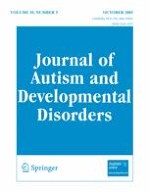01-10-2005
Modifying the Affective Behavior of Preschoolers with Autism Using In-Vivo or Video Modeling and Reinforcement Contingencies
Gepubliceerd in: Journal of Autism and Developmental Disorders | Uitgave 5/2005
Log in om toegang te krijgenAbstract
The purpose of this study was to modify the affective behavior of three preschoolers with autism in home settings and in the context of play activities, and to compare the effects of video modeling to the effects of in-vivo modeling in teaching these children contextually appropriate affective responses. A multiple-baseline design across subjects, with a return to baseline condition, was used to assess the effects of treatment that consisted of reinforcement, video modeling, in-vivo modeling, and prompting. During training trials, reinforcement in the form of verbal praise and tokens was delivered contingent upon appropriate affective responding. Error correction procedures differed for each treatment condition. In the in-vivo modeling condition, the therapist used modeling and verbal prompting. In the video modeling condition, video segments of a peer modeling the correct response and verbal prompting by the therapist were used as corrective procedures. Participants received treatment in three categories of affective behavior – sympathy, appreciation, and disapproval – and were presented with a total of 140 different scenarios. The study demonstrated that both treatments – video modeling and in-vivo modeling – systematically increased appropriate affective responding in all response categories for the three participants. Additionally, treatment effects generalized across responses to untrained scenarios, the child’s mother, new therapists, and time.
